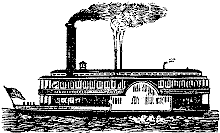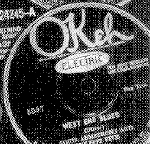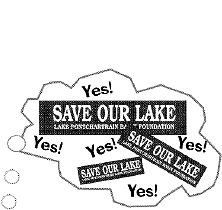
|
Antebellum Period (1810-1861)
- 1787: Destrehan Plantation was built by a free person of color and served as a freedmen's bureau after the Civil War.
- 1811: Enslaved Africans in St. Charles Parish revolted in what was possibly the largest revolt of enslaved people
American history.
- 1812: Louisiana becomes part of the United States after the Louisiana Purchase.
- 1815: In The Battle of New Orleans, Native Americans, free people of color, and European Americans fought together against the British, causing them to retreat.
- Several important ports flourish on Lake Pontchartrain's shores. Sailboats carry cargo and people between the Gulf of Mexico and the Lake Pontchartrain Basin ports.
-
Commerce grows on the south and north shores of Lake Pontchartrain. Exported products include: lumber, charcoal, bricks, shells, cotton, and oysters. Imported products include: raw materials and food unavailable locally.
- Madisonville on the northshore is an important boat building center.

- 1815: Travel by steamboat begins in the Lake Pontchartrain Basin, replacing many of the sailboats.
- The antebellum period is a time of wealth for some in the Lake Pontchartrain Basin. Large plantations spring up on the north and south shores, in the city of New Orleans, and along the Mississippi River.
- The wealthy spend their leisure time on the lake shore at several exclusive resorts, eating at the famous restaurants, gambling and enjoying the lake breezes. The first resort to open is at Spanish Fort at the mouth of Bayou St. John.
- 1831: The Pontchartrain Railroad connecting the city of New Orleans with the lakeshore is completed. Because of the railroad, a large resort area develops on the lakeshore at Milneburg. This resort boasts the beautiful Washington Hotel, a park, and a bath building. The Washington Hotel becomes a popular stopping point for travelers while the well-to-do of New Orleans spend pleasant weekends there.
- 1832: Norbert Rillieux, a free person of color, invented the vacuum pump for more efficient sugar processing.
- 1831-1838: The New Basin Canal is built using Irish immigrant labor, claiming the lives of many men who work on its construction. The canal serves as a transport route between downtown New Orleans and Lake Pontchartrain. Pleasure seekers take a mule-drawn barge, complete with musical entertainment, along the New Basin Canal to the resort at New Lake End (now known as West End).
- 1834: The Marigny Plantation in New Orleans gives way to the neighborhood of Faubourg Marigny so Bernard de Marigny moves across the lake to Fontainbleau, the family plantation on the northshore. He establishes the fashionable resort town of Mandeville. The Mandeville Hotel offers gambling, billiards, a bath house, and stables. People from New Orleans begin crossing the lake by steamer, seeking relief from the hot New Orleans summers.
The Civil War (1861-1900) and Afterwards
- Louisiana contributed more African American troops to the civil war than any other state.
- Many Louisiana forts were manned by African American troops.
- During the Civil War New Orleans is occupied by Union troops.
- The Civil War resulted in the abolition of slavery and passage of the 13th Amendment to the U.S. Consitution, thus ending a century of slavery.
- During Reconstruction, a tumultuous time, Louisiana had its first and only African American Governor, P.B.S. Pinchback. His governorship lasted only a month.

- Beginning around 1850, after many years of steamboat travel in the Lake Pontchartrain Basin, railroads are built. Many people now find it quicker and cheaper to travel by train. Several towns, including Slidell are built on the new railroads.
- Now it is not only the wealthy who get to enjoy the lakeshore resorts. Families spend their holidays by taking "Smoky Mary," the train to Milneberg where they fish and swim. They can also rent small lakeshore camps for the weekend.
- 1849: the Southern Yacht Club opens at West End.
- At the end of the 19th Century and the beginning of the 20th Century, cypress logging takes place. (Today the scars of the logging industry which neglected to replant the cypress trees can be seen in areas such as the marsh near Turtle Cove on Pass Manchac.)
- Leonard Julien, an African American, invented the cane planting machine in the late 19th Century.
- New Orleans, at the end of the 19th Century, was still an unhealthy place to live because of its poor drainage. Diseases such a yellow fever, malaria, tuberculosis, and intestinal infections, killed thousands of people in the Lake Pontchartrain Basin. It wasn't until the 1890's that taxes were raised to build a proper drainage system.
The 20th Century
- 1915: A huge hurricane hits New Orleans. Recent improvements in communication reduces the loss of life.

-
Buddy Bolden, considered the "father of jazz," was born in New Orleans in 1877 and died in 1931. The peak of his career was from 1890 to 1920. He played music at Milneburg and other lakeshore resorts. Louis Armstrong, who popularized jazz on an international level, was born in New Orleans in 1900 and died in 1971. He began his career around 1915 as a teenager. "West End Blues" was one of Armstrong's songs which featured the local scene.
-
1924: The Inner Harbor Navigation Canal, or the Industrial Canal is opened, linking the Mississippi River with the lake, aiding shipping commerce.
-
1927: The Mississippi River floods, causing great destruction, but much of the Lake Pontchartrain Basin is spared the worst.
- 1928: Pontchartrain Beach opens where Lake Vista is today.
-
1931: The Corps of Engineers builds the Bonnet Carre Spillway, a safety valve which can be opened when the Mississippi River floods, protecting New Orleans from high water. The water can be diverted from the river to Lake Pontchartrain.
- 1937: The Bonnet Carre Spillway is opened for the first time.
- In the early 1930s, Governor Huey P.
ng improves the state's highways and bridges, building the first bridge across the Mississippi at New Orleans.
-
In the 1930s and '40s, oil and gas exploration takes place in the Lake Pontchartrain Basin. Oil and gas related industries grow in the Lake Pontchartrain Basin. Due to environmental problems related to this industry, such as wetland loss from canal dredging, and pollution from oil spills, since 1992 there are no new oil and gas drilling leases allowed in Lake Pontchartrain.
-
Throughout the 20th century the population of the Lake Pontchartrain Basin grows. On the southshore Greater New Orleans spreads out to include Metairie and Kenner. This growth brings problems of drainage, sewage and storm protection.
- 1939: Pontchartrain Beach is moved to Milneburg.
-
During the Second World War the land near Lake Pontchartrain, where the University of New Orleans stands today, was used by Higgins Boats to build wartime vessels.
- Early 1950's: The hurricane protection levees are built along the southshore of Lake Pontchartrain, protecting the whole of metropolitan Orleans and Jefferson parishes from lake storm surges.
- 1956: The Lake Pontchartrain Causeway is completed. Now New Orleans and Mandeville are linked by road
for the first time.
- 1956-1964: Lincoln Beach Amusement Park was opened in 1956 and was a popular attraction for African Americans in New Orleans. It closed in 1964 and remains abandoned.
- 1963: The Mississippi River Gulf Outlet (MRGO) is opened to provide a short cut for
shipping from the Gulf of Mexico to New Orleans. It allows saltwater from the gulf to enter the St. Bernard marshes and Lake Pontchartrain, causing the loss of freshwater marshes and the conversion to water of much of the St. Bernard wetlands.
- 1965: Hurricane Betsy hits the Lake Pontchartrain Basin, causing flooding and other destruction in New Orleans and St. Bernard Parishes.
- 1960s: The I-10 is built from New Orleans to Baton Rouge, traversing the southshore of Lake Pontchartrain.
- The growing population and all the related development causes obvious degradation of the health of Lake Pontchartrain.
- 1960's: Many Cuban people emigrated to the Lake Pontchartrain Basin because of political changes in their country.
- 1970s: Large numbers of Central American people emigrated to the Lake Pontchartrain Basin primarily because of
litical unrest in several Central American countries. Many Asian people also arrived, including many Vietnamese fleeing their war-torn country.
- 1972: Pontchartrain Beach swimming area closes due to unacceptable levels of pollution which threaten the health of bathers.
- 1974-1982: Ernest "Dutch" Morial was elected the first African American mayor of New Orleans.
- 1979: "No swimming" advisories are posted along the lake's southshore in Orleans and Jefferson Parishes.
- 1983: Pontchartrain Beach Amusement Park closes for good, due mostly to lowered attendance. (Today some remnants of the famous Zephyr ride and other memorabilia are on display outside City Hall on Williams Boulevard in Kenner).
- 1987: The Tangipahoa River is declared unsafe for swimming and tubing due to high levels of fecal coliform bacteria.
- 1989: The Lake Pontchartrain Basin Foundation is established to restore the health of the lake and its rivers and to
otect the natural habitat of the basin. The Lake Pontchartrain Basin Foundation addresses environmental quality issues throughout the Lake Pontchartrain Basin and educates the public about their role in solving the problems. "Save Our Lake" becomes a popular slogan.
- 1990: Shell Dredging is halted in Lake Pontchartrain. The dredging, which had been ongoing for over 60 years, wreaked havoc on the Lake's ecosystem.
- The 1990s: In spite of great improvements, it is not yet safe to swim on the southshore of Orleans and Jefferson Parishes due to the urban runoff from the city streets. The Lake Pontchartrain Basin Foundation and researchers from the University of New Orleans monitor the lake water for fecal coliform bacteria, one of the main indicators of pollution. People still fish and boat throughout the Lake Pontchartrain Basin, but fishers report a decline in the quantity and quality of their catch.

- 2000: You will participate in the Lake Pontchartrain Basin's future. You can make a difference in many ways. Wherever you live in the Lake Pontchartrain Basin you can help to make sure the lake is a place for wildlife to live and people to go fishing, crabbing, shrimping, boating and swimming.

|







